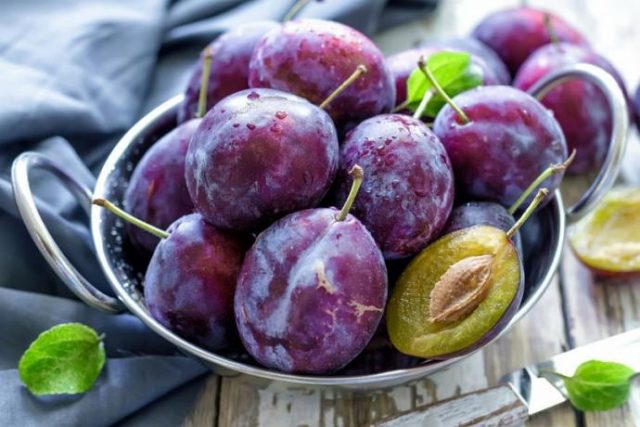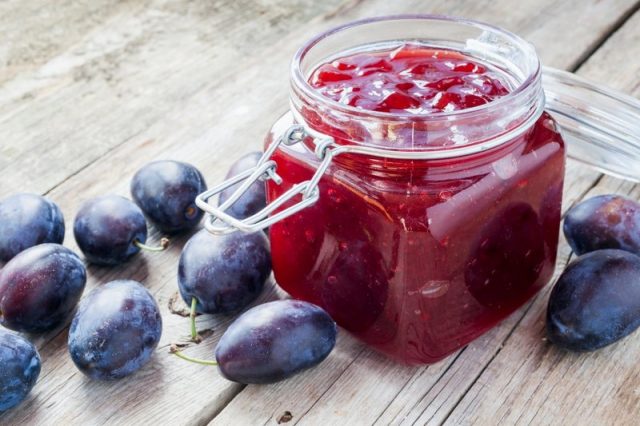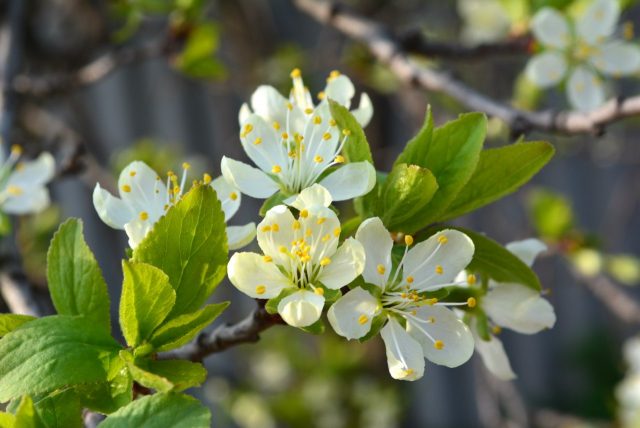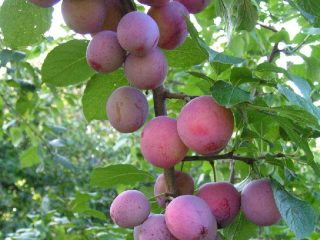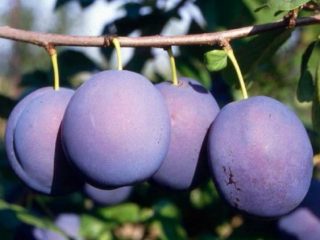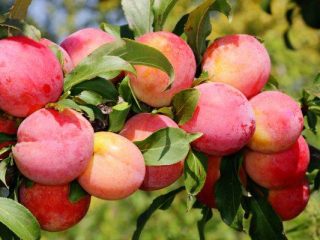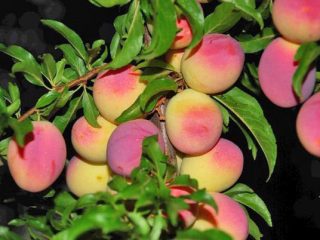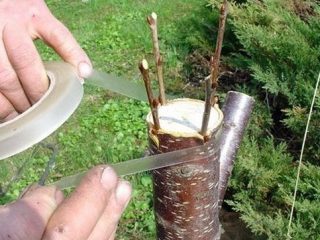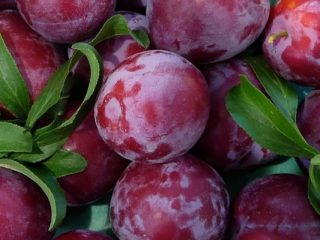Content
Plum Etude is the result of the work of G. Kursakov, who created an interesting variety from a hybrid. She is distinguished by special genetics - she practically never gets sick, is not susceptible to attack by pests, and loves both heat and cold.
History of variety selection
Homemade plum Etude is a variety created from two cross varieties with unique characteristics. The crossbreeding process involved the varieties Volzhskaya Krasavitsa and the hybrid Eurasia 21.
This event was held by G. Kursakov, who worked on his idea at the All-Russian Research Institute of Genetics and created an excellent specimen to confirm the correctness of the work. The breeder used fruit plants from Michurin’s garden, and in 1983 the experiment passed the test test “excellent”, after which home plum Etude was included in the State Register for the Central Black Earth region in 1985.Later, it began to be grown not only by amateurs, but also by professionals in this field.
Description of the plum variety Etude
Description of home plum The study can begin with a simple one - the variety grows in different regions. Most often it can be found in the Moscow, Leningrad, Voronezh regions and countries such as Moldova, Estonia, Ukraine, Kazakhstan and Belarus. Gardeners note that the homemade plum variety Etude is very easy to care for and is resistant to drought and severe frosts. Heat or cold is not a problem, pests and diseases are not a threat.
Homemade plum variety Etude is considered a mid-early crop. In winter, the buds and bark of trees do not freeze and do not suffer from frost. During the hot summer season, the tree does not dry out and patiently withstands any temperature. His description is as follows:
- The tree is not tall, reaching a height of about 2 meters, which is enough to obtain a rich harvest.
- The crown is round, the root system is well developed and can withstand heavy loads.
- The branches of the skeleton have a slightly uneven relief surface with roughness.
- The bark is brown with a slight gray coating.
- The shoots have a brown tint and are quite thick.
- Small, oval-shaped buds do not press against the shoots.
The leaves also have an oval shape. In the homemade plum variety Etude, they are large, with a non-sharp top. The flowers are large with oval petals and do not touch each other, creating beautiful inflorescences. The Etude plum itself produces gorgeous fruits - 30 grams of delicious juicy fruit. Oval, smooth contours, beautiful rich colors, giving off a reddish tint. The skin of the Etude plum is quite hard and dense, there is a thick coating of wax particles.
The seed of the domestic plum variety is small and easily separated from the pulp.The pulp is greenish, rich in juice, sweet, tender. The dense consistency allows you to make some homemade dishes from the fruit. The tasting score for the Etude plum is 4.4 points.
Characteristics of the variety
Since the height of the Etude plum tree is small, the variety can bear up to 60 kg of ripe fruit. The habitual flowering in early spring produces fruits in late season or early summer. The table-technical variety is loved by many farmers and owners of personal plots. The home plum variety Etude is ideal for growing.
Drought resistance, frost resistance
At temperature +35 0Plum can hold fruit for a long time without dropping it on the ground. Strong crowns can withstand the entire harvest. In winter at temperatures of -30 0The tree does not freeze and is not attacked by pests and rodents.
This is a truly unique variety of domestic plum that grows in almost any soil at different latitudes of the planet. Also, the humidity parameter, which varies in Moldova, Ukraine and Belarus, is not fundamental.
Plum pollinators
The home plum variety Etude is considered partially self-fertile, so for pollination it is necessary to plant pollinating trees nearby. A good solution would be to plant the varieties Zarechnaya Rannyaya, Volzhskaya Krasavitsa and Renklod Tambovsky.
Productivity and fruiting
The Etude plum blossoms quickly from the end of May. The domestic plum tree produces fruit in a short period of time, and the ripening period is average. Therefore, you will be able to enjoy delicious fruits only in August.
Fruiting is annual, but is characterized by a stable increase - approximately 2-3 kg with each subsequent season. Homemade plum Etude can produce either 20 kg or 60.It all depends on how mature the tree is. The seedlings are already bearing fruit in their 4th year, so you won’t have to wait long for the harvest.
Area of application of berries
The home sketch is very easy to transport. Plums are stored in containers and industrial refrigeration chambers, where they do not lose their appearance and taste for 2-2.5 months. Used for winter preparation and fresh consumption.
Resistance to diseases and pests
Homemade plum variety Etude is not susceptible to disease. Rodents also do not attack the crowns and trunk, so it is unpretentious in care. Seedlings and mature trees are not covered with nets or paper, or wrapped in tarpaulins or fabrics. It turns out that the garden can do without additional care all year round.
Advantages and disadvantages of plum Etude
It blooms quickly and produces large fruits - this is what is valued in the Etude plum variety. The pickiness of the tree is its peculiarity.
Landing Features
Homemade plum variety Etude requires a special approach to planting. The seedlings must be two years old; before planting, they are placed in a limestone solution so that the roots “get used” to the soil.
Recommended timing
Homemade plum Etude can be planted in the spring, but the optimal time of year is autumn.
Choosing a suitable location
The soil for home Etude must be breathable. The best option would be moisture-saturated loams. There should be no acids in the soil, and it is advisable to check this - a neutral reaction means planting is possible. Finding a southern, flat area in the garden is quite easy, but you should not improve it. Home plum Etude does not need this.
What crops can and cannot be planted nearby?
For pollination, you need to plant the varieties listed above. It is not recommended to plant hybrids - they have a bad effect on yields. It is also not recommended to plant vegetable gardens with various fruits and vegetables; it is better to separate fruit plantings from other crops. Of course, there is nothing prohibited in planting other domestic plums, but each tree only has two or three pollinators. To grow a large garden, you need to devote more than half of the space to these purposes.
Selection and preparation of planting material
Before planting, a hole with dimensions of 70 x 50 x 60 is dug, into which humus and nitrophoska are added to the bottom. The mixture should form a slide, the mass will be 2/3 of the total volume of the pit.
Landing algorithm
After installing the seedling in the hole, you need to drive a peg in the middle, which will serve as support for the tree.
Clay is poured nearby (to the side). The roots need to be distributed evenly so that the tree “grabs.” The soil is trampled after filling the hole and watered when finished.
It is advisable to make a hillock rather than a ditch so that the tree can stand, since the roots of the Etude seedling are quite fragile. Additionally, you can follow the video:
Aftercare for plums
Further care involves digging up the areas. This should be done in spring and autumn to renew the ground cover. Around the Etude plum trees you need to water, weed and remove all debris from there. Weeds are removed so that they do not interfere with the further growth of the plum. There is no need to cover the trunks for the winter; the domestic plum variety Etude is very resistant to winter and frost.
Water the tree only in very hot weather. Plum Etude receives up to 1-2 waterings per week, but if it is very stuffy, you need to increase the amount up to three times.
Diseases and pests, methods of control and prevention
The Etude domestic plum variety is not susceptible to pests and does not get sick, so preventive spraying is not required. There is also no need to treat or treat the soil with drugs. However, rotting leaves should be removed in any case, even if there are no prerequisites for disease. It is advisable to remove all small blades of grass and plants that do not belong near the table plum variety Etude.
Conclusion
Plum Etude is an excellent variety for the home garden. This variety of plum is very sweet, and most importantly, it never gets sick and is not “interesting” to rodents and insects. It can be grown at home on a country plot, on farms.




